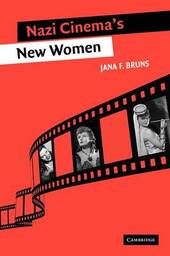
|
Nazi Cinema's New Women
Paperback / softback
Main Details
| Title |
Nazi Cinema's New Women
|
| Authors and Contributors |
By (author) Jana F. Bruns
|
| Physical Properties |
| Format:Paperback / softback | | Pages:286 | | Dimensions(mm): Height 229,Width 152 |
|
| Category/Genre | Individual actors and performers
Films and cinema |
|---|
| ISBN/Barcode |
9781107405103
|
| Classifications | Dewey:791.43028092243 |
|---|
| Audience | | Tertiary Education (US: College) | |
|---|
| Illustrations |
Worked examples or Exercises
|
|
Publishing Details |
| Publisher |
Cambridge University Press
|
| Imprint |
Cambridge University Press
|
| Publication Date |
19 July 2012 |
| Publication Country |
United Kingdom
|
Description
This book examines the careers of three of Nazi cinema's preeminent movie actresses, painting a unique portrait of mass entertainment and stardom under Nazi rule. Bruns uses undiscovered sources and a new approach, which integrates visual analysis within a thorough political and social context, to trace how the Nazis tried to use films and stars to build National Socialism. This analysis focuses on female stars - an important but largely unexplored area - because they were mostly responsible for Nazi cinema's spectacular commercial success and political failure. Challenging earlier studies, which view Nazi cinema as an effective propaganda instrument that helped turn Germans into devoted 'Aryan' mothers and tough warriors, the book shows that the Nazi regime's liaison with the cinema was ambivalent. Films failed to disseminate a coherent political message and to Nazify German society. However, they helped the regime maintain power by diverting people's attention from the brutality of Hitler's rule and, eventually, from impending defeat.
Reviews'Studies in this pathbreaking book which combines commendable archival research with sophisticated theoretical analysis. She demonstrates conclusively that the film roles played by three representative female stars during the golden age of UFA studios - Marika Roekk, queen of the popular review film genre, sensuous Zarah Leander, model of sacrifice for the national cause, and Kristina Soederbaum, a beautiful Nordic woman who repeatedly falls victim to the forces of evil - all reflect the deep complexity and moral ambiguity of issues when viewed through the lens of national socialist ideology.' Jay W. Baird, author of Hitler's War Poets 'This book, which adds to the growing scholarship on culture and cultural production in modern Germany, especially during the Nazi era, is well researched, elegantly written, fascinating, and a pleasure to read. Bruns' work is a welcome addition to the scholarship on Nazi propaganda and its quality of scholarship is high and its research impressive. Bruns scoured German archives and libraries for correspondence by and about movie stars and their efforts; for film magazines from the 1930s and 1940s; and for memoirs by a range of cinema people. Most of these sources are relatively unknown to historians of Nazism, and even experts in the filed will discover much that is new to them here.' Doris Bergen, University of Toronto 'Bruns has written an impressive, nuanced historical study of the relationship between the Nazi state and the German film industry, focusing on three of the industry's most popular female stars: Marika Roekk, Zarah Leander, and Kristina Soederbaum. The book makes a valuable contribution to the scholarly discussion of these three performers, providing the first extended study of Roekk's career, enhancing our understanding of Leander through her rigorous historical research, and offering unique insight into Soederbaum, finding many contradictions in the screen image of this star, who seemed much more the model 'Aryan' woman than the other two stars. Bruns demonstrates how ambiguous the relationship of each of these three female stars was to Nazi ideology - but not necessarily in any clearly 'subversive' way.' Rick McCormick, University of Minnesota '... Bruns succeeds in adding nuance, complexity, and richness to our understanding of Nazi cinema and its leading actresses, Soederbaum, Roekk, and Leander. Through her comparative analysis of three film stars, both on and off the big screen, and her two-fold - textual and historical - approach, Bruns shines an unsparing light on the unresolved ambivalence that market both gender ideology and film policy in Nazi Germany.' The Journal of Central European History
|